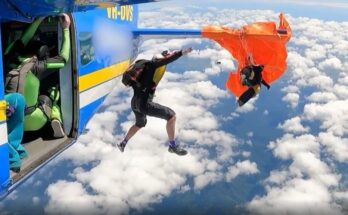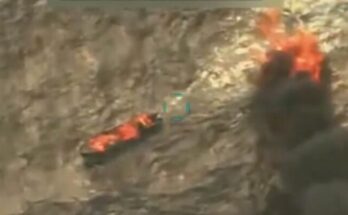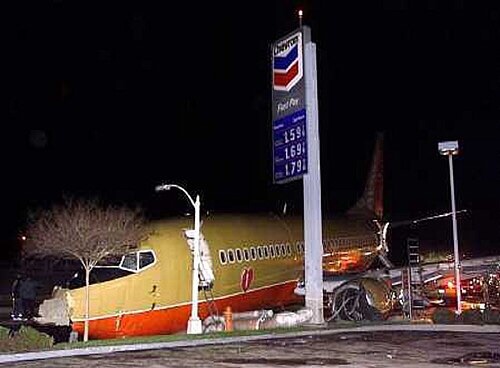
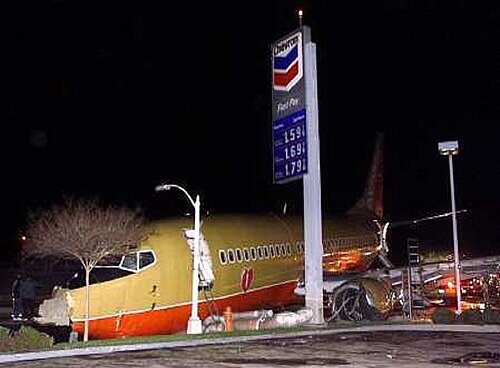
The captain was 52-year-old Howard Peterson, who had been with Southwest Airlines since 1988 and had logged 11,000 flight hours, including 9,870 hours on the Boeing 737. The first officer was 43-year-old Jeffrey D. Erwin, who had been with Southwest Airlines since 1995 and had 5,032 flight hours, with 2,522 of them on the Boeing
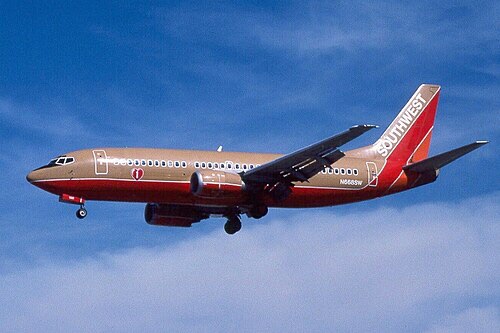
At 18:04:42 the first officer informed the captain that the target airspeed for landing would be 138 knots (159 mph; 256 km/h). This value was based on standard procedures in the Southwest Airlines Flight Operations Manual (FOM). At 18:05:13 the captain told the first officer that the air traffic controller had instructed them to remain at 230 knots (260 mph; 430 km/h) or greater “for a while.”
At 18:05:54 the controller cleared Flight 1455 to descend to 5,000 feet (1,500 m), and at 18:07 cleared the flight to descend to 3,000 feet (900 m). At 1808 the controller cleared flight 1455 for a visual approach to runway 8 with a restriction to remain at or above 3,000 feet (above mean sea level) until passing the Van Nuys VORbeacon. This navigational aid is approximately 6 miles (5 nmi; 10 km) from the runway. Radar data suggest that the flight began its descent from 3,000 feet (910 m) about 4 miles (3 nmi; 6 km) from the runway.[6]
According to the Aeronautical Information ManualSection 4-4-12f,[7] this approach clearance automatically canceled any previous speed assignments. According to the final accident report, traffic conditions no longer warranted the speed assignment after the controller cleared the flight to descend to 3,000 feet (910 m), but the controller did not verbally cancel the speed assignment.
Southwest Airlines procedures then in place had the non-flying pilot (pilot monitoring) make altitude call-outs at 1000, 500, 400, 300, 200, 100, 50, 30, and 10 feet (3.0 m). Additionally, call-outs are required if certain parameters are not met, in this case flight speed and sink rate. At 18:09:32, one minute and thirteen seconds after approach clearance was given, and at 3,000 feet (910 m) of altitude, the captain began to slow the aircraft by deploying the flaps.
At 18:10:24 the ground proximity warning system(GPWS) began to sound a “sink rate” warning in the cockpit. The aircraft was descending at an angle of 7 degrees, when the angle of descent for most aircraft landing on that runway was 3 or 4 degrees. Both pilots ignored the warnings. At 18:10:44 the warning system in the cockpit began to sound. The captain responded to these warnings with “that’s all right.”
The captain stated after the accident that he knew as the aircraft passed 500 feet (150 m) that he was not “in the slot,” meaning the conditions had not been met for a safe landing, in this case because of an excessive airspeed. The captain further stated that he understood that if he was not “in the slot,” procedures demanded a go-around maneuver to abort the landing. He could not explain why he did not perform a go-around maneuver. The first officer likewise indicated after the accident that he was aware that they were not “in the slot,” but said he believed the captain was taking corrective action.
The aircraft touched down on the wet runway at 44 knots (51 mph; 81 km/h) over the target airspeed. Furthermore, it touched down 2,150 feet (660 m) from the runway threshold, 650 feet (200 m) beyond the 1,000–1,500-foot (300–460 m) range established by the Southwest Airlines FOM. The captain deployed the thrust reversers and then he and the first officer applied manual brakes, but according to later NTSB findings, under those conditions even maximum braking would not have prevented the aircraft from overrunning the end of the runway.
Unable to stop in time, the Boeing 737 overran the end of Runway 8. “The airplane touched down at approximately 182 knots (209 mph; 337 km/h), and about 20 seconds later, at approximately 32 knots (37 mph; 59 km/h), collided with a metal blast fence and an airport perimeter wall.”[5] It finally came to rest on Hollywood Way, a four-lane city street, near a Chevron gas station. The tip of the aircraft’s nose and its front landing gear were sheared off, but otherwise the fuselage remained intact and there was no compromise of the cabin area. However, the 737 sustained structural damage from the accident and was later scrapped.
